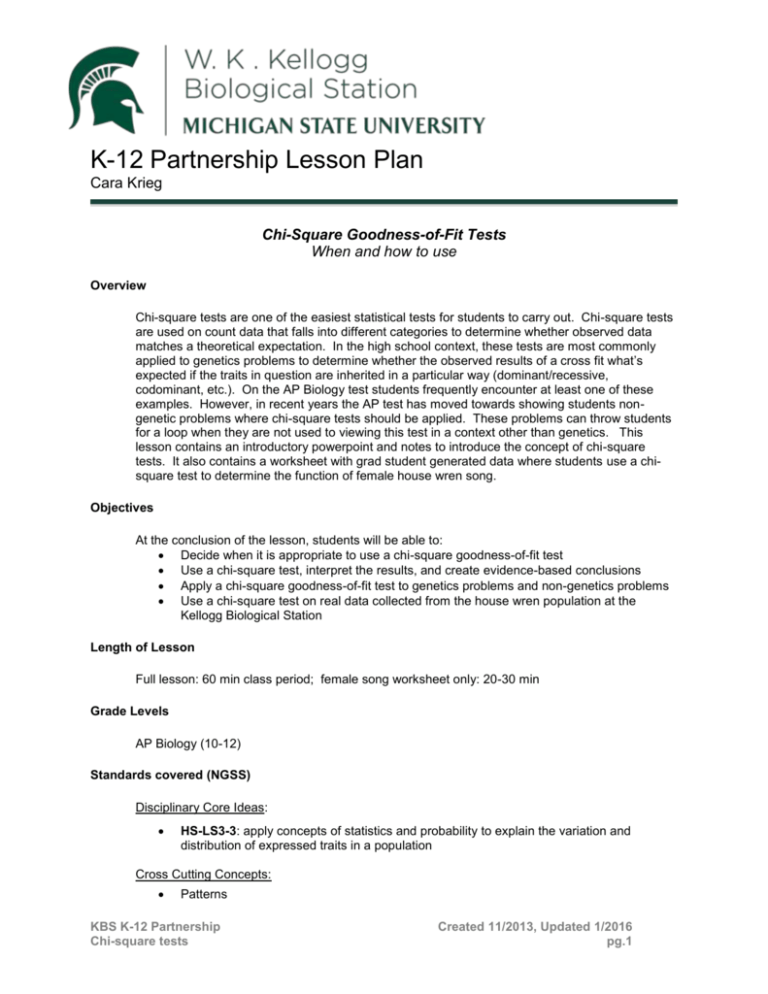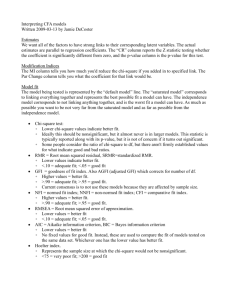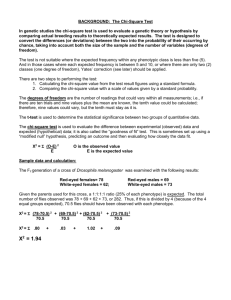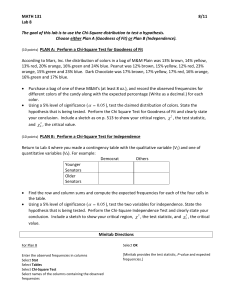Chi-Square Goodness-of-Fit Tests
advertisement

K-12 Partnership Lesson Plan Cara Krieg Chi-Square Goodness-of-Fit Tests When and how to use Overview Chi-square tests are one of the easiest statistical tests for students to carry out. Chi-square tests are used on count data that falls into different categories to determine whether observed data matches a theoretical expectation. In the high school context, these tests are most commonly applied to genetics problems to determine whether the observed results of a cross fit what’s expected if the traits in question are inherited in a particular way (dominant/recessive, codominant, etc.). On the AP Biology test students frequently encounter at least one of these examples. However, in recent years the AP test has moved towards showing students nongenetic problems where chi-square tests should be applied. These problems can throw students for a loop when they are not used to viewing this test in a context other than genetics. This lesson contains an introductory powerpoint and notes to introduce the concept of chi-square tests. It also contains a worksheet with grad student generated data where students use a chisquare test to determine the function of female house wren song. Objectives At the conclusion of the lesson, students will be able to: Decide when it is appropriate to use a chi-square goodness-of-fit test Use a chi-square test, interpret the results, and create evidence-based conclusions Apply a chi-square goodness-of-fit test to genetics problems and non-genetics problems Use a chi-square test on real data collected from the house wren population at the Kellogg Biological Station Length of Lesson Full lesson: 60 min class period; female song worksheet only: 20-30 min Grade Levels AP Biology (10-12) Standards covered (NGSS) Disciplinary Core Ideas: HS-LS3-3: apply concepts of statistics and probability to explain the variation and distribution of expressed traits in a population Cross Cutting Concepts: Patterns KBS K-12 Partnership Chi-square tests Created 11/2013, Updated 1/2016 pg.1 Scale, proportion, and quantity Science and Engineering Practices Asking questions and defining problems Analyzing and interpreting data Using mathematics and computational thinking Engaging in argument from evidence Chi-square goodness of fit tests are also listed in AP Biology Quantitative Skills Guide Materials ● ● ● ● Calculators (1 per student) Powerpoint Student handout to accompany powerpoint House wren student worksheet (all material available on “Chi-square tests” lesson page on the KBS GK-12 website Background Chi-square goodness-of-fit tests Researchers often need to decide if the results they observe in an experiment are close enough to predicted theoretical results so that the tested hypothesis can be supported or rejected. For example, do a series of coin flips match what you’d expect to get by chance, or is their evidence the coin is unfair? Does the number of women interviewed for a job position match the proportion of women in the applicant pool, or is there evidence of bias? Does the number of white-eyed fruit fly offspring match the number expected if the white-eyed trait is recessive, or are white-eyes inherited in some other way? Chi-square tests come in two types, chi-square tests for independence (not addressed here) and chi-square goodness of fit tests. This is test is used to determine if observed data matches theoretical or expected results. These tests are commonly used in genetics but also have many other uses. This lesson contains one genetics example (under the assumption these will be practiced much more thoroughly in subsequent classes) and one practice and one worksheet example of a chi-square test in a non-genetics context. A chi-square goodness-of-fit test is used when: (1) your response variable is count data, (2) your response falls into different categories, (3) you have a hypothesis for the responses you expect, and (4) you want to know if the difference between the responses you observe and the responses you expect is significant or not. If the chi-square test shows your data is not significantly different from what you expected, you support the hypothesis. If your data is significantly different you reject the hypothesis as an explanation for your data. Remember, no statistical test can ever prove a hypothesis, only fail to reject it. The student handout goes through the basic steps of calculating a chi-square goodness-of-fit test. Female house wren song background Male songbirds are prolific singers during springtime in temperate zone regions like Michigan. Males use song to attract females and defend territories. For a long time scientists have thought only males in temperate regions sing and females are silent. However, a KBS grad student discovered that female house wrens actually sing quite frequently, although this behavior has been overlooked until now. Female song is incredibly variable between different females and songs very different from male house wren song. This grad student wanted to know why female house wrens sing. KBS K-12 Partnership Chi-square tests Created 11/2013, Updated 1/2016 pg.2 Several hypotheses have been proposed to explain why female birds in the tropics sing. Song can help coordinate male and female behavior, can solicit copulations from males, or can be used to defend nests/territories from other wrens. After male house wren attracts a female, the male and female work together to build a stick nest inside their nesting cavity. Male and female behavior is also coordinated when they are working together to feed nestlings after the eggs hatch. If females sing to coordinate with the males, song should be most common during nest building and drop once the eggs are laid. If female song is used to solicit copulations from the male, female song should be most common when she is fertile. Females are fertile several days before they start egg laying until the second to last day in the egg laying period. Females lay one egg a day until the clutch is complete and typically mate again for each egg. If female song is used to defend nests from other wrens, song should be most common when other wrens are the biggest threat. Male and female house wrens will readily commit ovicide (aka kill eggs) if they find them unattended. The female doesn’t begin incubating her eggs until her clutch is complete and spends the early part of the egg laying period frequently away from her eggs, foraging to gather energy to make her next egg. During this time, her nest is at most risk from intruding birds. This threat drops dramatically once she is incubating and spending the majority of the day sitting on her eggs. As a null hypothesis to all of these alternatives, female song may just occur randomly across the breeding cycle. If there is evidence to support this hypothesis, we can reject all the alternatives above. This is a perfect scenario to use a chi-square goodness-of-fit test! Activities of the session 1. (If using this lesson to introduce chi-square). Start with the introductory powerpoint in conjunction with the chi-square note sheet. More specific details are available in the powerpoint notes. Work through slides 1-9. 2. Do example one on the notes sheet together as a class. Return to the powerpoint to explain how to read a chi-square probability table (more specific details in powerpoint notes). 3. Do example two on the notes sheet. Demonstrate how to get expected values from ratios, as this is a step that trips students up later down the road. Let students work together on filling out the rest of the chi-square table. 4. (Start here if only doing female song worksheet) Slides 16-20 set up the background to the female song worksheet example. You may also want to work as a class to get the first expected value before letting students work independently. Resources Introductory lesson handout for students Teacher guide Powerpoint House wren worksheet for students Teacher guide (all materials on “Chi-square test” lesson on the KBS GK-12 website) Online chi-square table: http://sites.stat.psu.edu/~mga/401/tables/Chi-square-table.pdf Numerous websites, such as (http://stattrek.com/chi-square-test/goodness-of-fit.aspx) provide additional background on chi-square goodness-of-fit tests. For more practice, see Bonnie McGill’s “The chi-square goodness of fit test: applications for testing genetic inheritance hypotheses” lesson on the KBS GK-12 website Extensions and Modifications This lesson can be used in full to introduce chi-square goodness of fit tests or the female song worksheet can be used to practice chi-square tests using a non-genetics example. For full KBS K-12 Partnership Chi-square tests Created 11/2013, Updated 1/2016 pg.3 mastery of this technique, this lesson should be followed up with more standard genetics problems using this chi-square test. Assessment The house wren worksheet can be used as a homework assignment to assess student understanding. KBS K-12 Partnership Chi-square tests Created 11/2013, Updated 1/2016 pg.4







